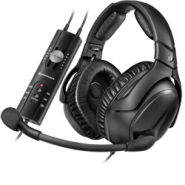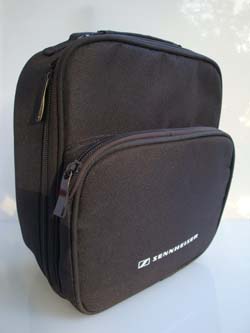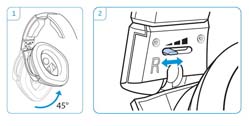Headset – Sennheiser S1 Passive

Sennheiser S1 Passive
Take a good look around the many aviator forums and one of the most frequently asked questions is ‘What’s the best headset ?’ . No doubt you will have seen replies such as ‘there is no ‘best’ headset’ – ‘you do not need to go spending large amounts of money on headsets’ – ‘Try and test before you buy’. Guess what, that’s exactly how it is !
What do you really need?
There is no escaping the fact that there is some snobbery within the world of aviators. There will always be those that have to have the latest spec, even if it costs them £1000 for it, yes I did just say £1000 for a headset. These people will always recommend the high price headsets to anyone that asks. I don’t know if it’s just so they can say they have one or if its an evaluated opinion. Now I’m not saying the high priced headsets are no better than those half or a third of the price. But what I will say is, do you really need the quality you will gain from the extra £600 it may cost you ? Headsets are normally in one of two groups, Passive Noise Reduction (PNR) or the more expensive Active Noise Reduction (ANR)
Passive Noise Reduction – PNR
This mode works in both a mechanical and electrical way. The clamping force of the headset, coupled with soft gel ear cups, create a tight fit around the ear and manually stop noise getting in. They also have a form of ANR built in, but is not as effective as the dedicated ANR units. Due to the way PNR headsets work regarding the clamping forces, they can become uncomfortable after long use. So its important to look at features on the headset such as GEL seals instead of foam and is the clamping force adjustable.
Active Noise Reduction – ANR
This mode uses the un-required noises coming into the headset to generate an opposing noise, of which it emits into the ear cup. This results in cancelling out the noise and you do not hear it. An ANR headset will cancel out a higher decibel range and so sound much quieter. Due to the electronics doing the work of noise cancelling, they do not need to clamp to the head quite as much as the PNR headsets. This makes them more comfortable during expended periods of flying.
My decisions
I chose the Passive route for two reasons…  The starting price for ANR headsets was more than my budget & sometimes you actually want to be able to hear certain noises around you when learning, such as the engine tone.
The starting price for ANR headsets was more than my budget & sometimes you actually want to be able to hear certain noises around you when learning, such as the engine tone.
So with that decision made, I started to look at the PNR market and what was on offer. You will always get pointed towards the Dave Clark products. People will swear by them and so they should, they work for them. This is something you will have to remember when reading write ups on headsets. What may suit one particular head shape and ear lobe, could be very uncomfortable to another. I have read more write ups on Dave Clark headsets that stated they had quite a high clamping force, especially if you possessed a large head, than I did saying they were a very comfortable fit. I would class myself as having a quite large head and so I dismissed the Dave Clark range.
See, you are reading this and I am saying I didn’t go down the Dave Clarke route, yet I have not even tried a pair on ! They might actually fit very well indeed ! But without a pilot supplies supermarket in the area, I cannot just pop out and try a pair on. I was attracted to the Sennheiser range, a well known manufacturer of audio headsets. Originally I was going to go for the HME 110’s at approx £235, a good starting price and starter headset. I then noticed the S1 range and in particular the S1 Passive headset, retailing from £299 at the time. I liked the extra features and decided in the long run it would be worth while spending the extra £65.
My Choice
So, how has the Sennheiser S1 Passive headset performed, and what are the features that attracted me to it ? As for performance, my longest lesson to date has been just over an hour. I am yet to take them off yet thinking ‘thank god for that’ or ‘my heads starting the hurt’, even whilst wearing sunglasses. So from a 1 hour perspective, this headset is very comfortable.
It does have 3 different clamping settings, of which can be selected via a slider on the inside of the headband. It’s just above each ear cup, so it does accommodate different sized heads. I have mine  set to either the middle or smallest force setting. The tightest force does feel very very tight on my head, and I can see that being an issue after a short while.
set to either the middle or smallest force setting. The tightest force does feel very very tight on my head, and I can see that being an issue after a short while.
I have no issues hearing my instructor, and he reports no issues hearing me, which indicates the boom mic works well. I had read reports that people had complained the boom mic was not long enough for them, it reaches just fine for me.
The headset comes with a control unit with which you can adjust the volume to each ear and select either mono/stereo output. There is also a switch to turn on the special feature which allows you to connect a mobile phone or music player via a 3.5 jack. This gives you the choice to listen to music on a long solo cross country flight or be able to take and make calls whilst in the air. The unit will auto mute the input device should any radio communications be made, so you wont’ miss any important information. It is also said that trying to get a mobile phone signal over a few thousand feet is tough going, the mobile phone masts don’t point up that much to send a signal high into the air.
Conclusion
So, am I happy with my purchase ? Yes I am. Well built, not too heavy, no issues with headaches due to clamping forces and some extra features for when I’m solo. I can sing as loud as I like and nobody is going to hear me !
Would I recommend this headset to anyone else ? Yes I would. But should anybody ask me if they are better than another model in the price range, the answer would be, I don’t have a clue.
